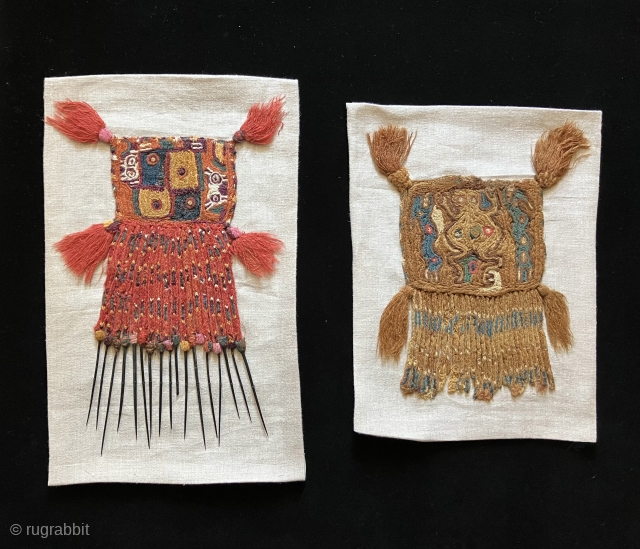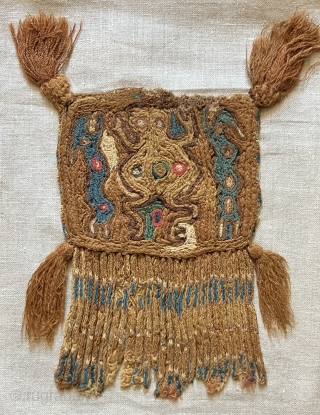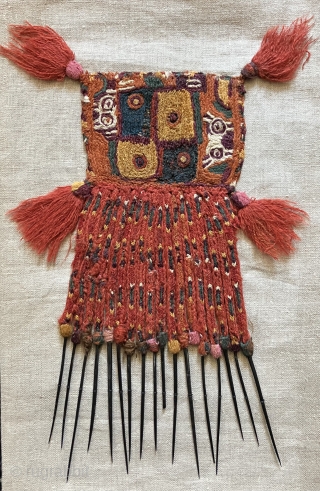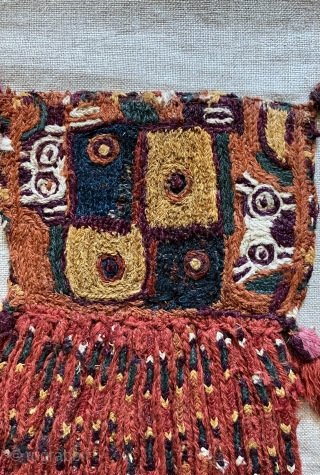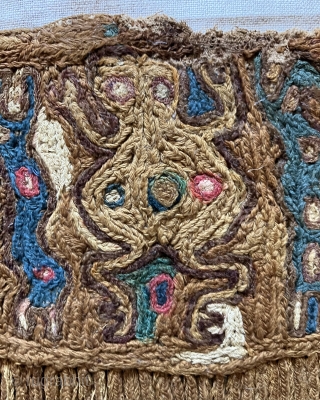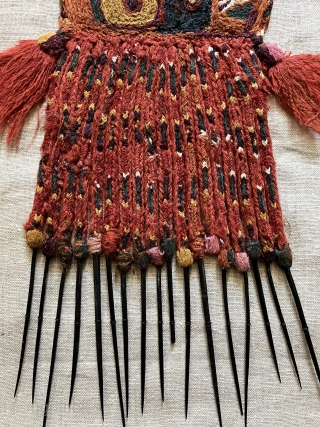Back
Rare and primitive Pre-Columbian textile pendants. Researching the literature has yielded less than seven of this kind of textile and each example is unique as regards iconographic content - so they are indeed quite rare. These captivating little pieces are mysterious and likely made as tassels or pendants. Evidence shows that cactus spines were originally incorporated into each example which in some pieces have been lost. Cactus spines like these were often used for sewing needles in pre-Columbian times. The images included here are that of a frog-like figure flanked by blue double headed snakes and in the piece with cactus spines still intact, profile double headed creatures are seen with rectangles containing circles. Some examples of the type are attributed to the Wari or Nasca Cultures and some to the Chimu Culture. In any event they would date to between a.d. 500 - 1200. They are worked in a folky, embroidery structure using alpaca, cotton and what appears to be cactus fiber. Three and a half inch cactus spines (very sharp) dangle from the braided tassels. Size approximately 6 x 12 inches including cactus spines. These two pieces were once stabilized and mounted to linen fabric and framed but they have since been cut from the frames. They could be easily re-mounted for display purposes. There are two related pieces now in the Yale museum collection and published in Vanessa Drake Moraga's seminal work, Animal Myth and Magic - Images from Pre-Columbian Textiles, plates 58 and 99. i sold the two examples posted here some years ago to a London collector who recently passed away. Fascinating collector pieces and easy to display.
price:
inquire directly to jameswblackmon@gmail.com
- Home
- Antique Rugs by Region
- Category
- Profiles
- Post Items Free
- Albums
- Benaki Museum of Islamic Art
- Budapest: Ottoman Carpets
- Gulbenkian Museum
- Islamic Carpets. Brooklyn
- Islamic Textiles. Brooklyn
- Konya Museum: Rugs
- MKG, Hamburg
- MMA: Caucasian Carpets
- MMA: Mamluk Carpets
- MMA: Mughal Indian Carpets
- MMA: Ottoman Carpets
- MMA: Safavid Persian Carpets
- MMA: Turkmen Rugs
- McCoy Jones Kilims
- Ottoman textiles. Met
- Philadelphia Museum
- Rugs and Carpets: Berlin
- Seljuqs at the Met
- TIEM, Istanbul: Carpets
- V&A: Classical Carpets
- Vakiflar Carpets: Istanbul
- Baluch Rugs: Indianapolis
- Gallery Exhibitions
- Jaf an Exhibition
- Alberto Levi Gallery
- Andean Textile
- Christie's London: 2016
- Francesca Galloway
- HALI at 40
- ICOC Washington, DC 2018
- Jajims of the Shahsavan
- London Islamic Week April, 2018
- Mongolian Felts
- Navajo Rugs: JB Moore
- Persian Piled Weavings
- SF Tribal & Textile Art Show 2020
- SF Tribal 2019
- Sotheby's: C. Alexander
- Turkish Prayer Rugs
- Turkmen Main Carpets ICOC 2007









